

Compact Muon Solenoid
LHC, CERN
| CMS-EXO-15-007 ; CERN-EP-2017-074 | ||
| Search for black holes in high-multiplicity final states in proton-proton collisions at $ \sqrt{s} = $ 13 TeV | ||
| CMS Collaboration | ||
| 3 May 2017 | ||
| Phys. Lett. B 774 (2017) 279 | ||
| Abstract: A search for new physics in energetic, high-multiplicity final states has been performed using proton-proton collision data collected with the CMS detector at a center-of-mass energy of 13 TeV and corresponding to an integrated luminosity of 2.3 fb$^{-1}$. The standard model background, dominated by multijet production, is determined exclusively from control regions in data. No statistically significant excess of events is observed. Model-independent limits on the product of the cross section and the acceptance of a new physics signal in these final states are set and further interpreted in terms of limits on the production of black holes. Semiclassical black holes and string balls with masses as high as 9.5 TeV, and quantum black holes with masses as high as 9.0 TeV are excluded by this search in the context of models with extra dimensions, thus significantly extending limits set at a center-of-mass energy of 8 TeV with the LHC Run 1 data. | ||
| Links: e-print arXiv:1705.01403 [hep-ex] (PDF) ; CDS record ; inSPIRE record ; CADI line (restricted) ; | ||
| Figures | |
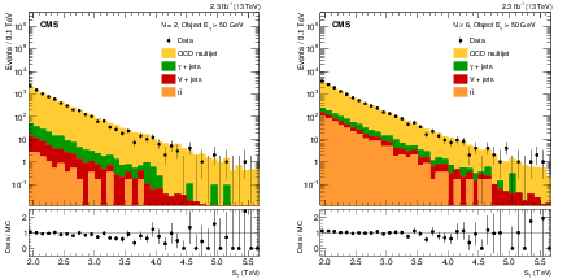
png pdf |
Figure 1:
Contributions of the main QCD multijet background, as well as $ \gamma $+jets, V+jets (V = W, Z ), and ${{\mathrm{ t } {}\mathrm{ \bar{t} } } }$ backgrounds to the $ {S_{\mathrm {T}}} $ distribution for (left ) exclusive multiplicity $N= $ 2 and (right ) inclusive multiplicity $N \ge $ 6. |

png pdf |
Figure 1-a:
Contributions of the main QCD multijet background, as well as $ \gamma $+jets, V+jets (V = W, Z ), and ${{\mathrm{ t } {}\mathrm{ \bar{t} } } }$ backgrounds to the $ {S_{\mathrm {T}}} $ distribution for exclusive multiplicity $N= $ 2. |
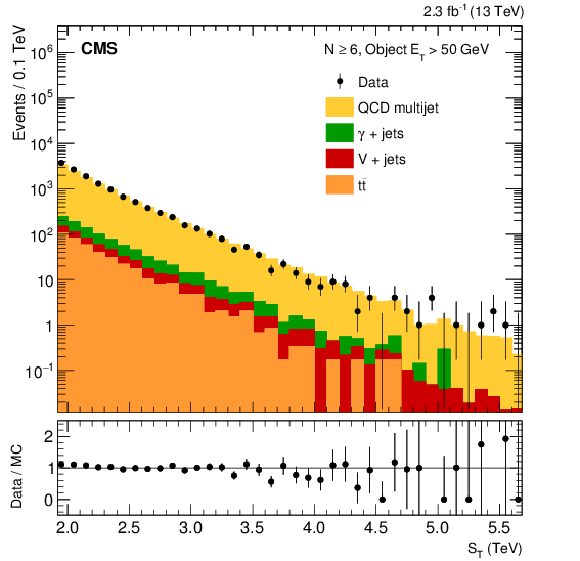
png pdf |
Figure 1-b:
Contributions of the main QCD multijet background, as well as $ \gamma $+jets, V+jets (V = W, Z ), and ${{\mathrm{ t } {}\mathrm{ \bar{t} } } }$ backgrounds to the $ {S_{\mathrm {T}}} $ distribution for inclusive multiplicity $N \ge $ 6. |

png pdf |
Figure 2:
The distributions of the total transverse energy, $ {S_{\mathrm {T}}} $, for inclusive multiplicities of objects (electrons, muons, photons, or jets) $N\geq $ 2, 3, 4, 5. Observed data are shown by points with error bars, the solid blue lines along with the grey shaded band show the main background estimation (central blue line), along with the uncertainty band (outer blue lines). The deviation of the fit from the data is shown in each lower pane. The top two plots also show predictions for two quantum black hole benchmark scenarios added to the corresponding background predictions. |

png pdf |
Figure 2-a:
The distribution of the total transverse energy, $ {S_{\mathrm {T}}} $, for inclusive multiplicities of objects (electrons, muons, photons, or jets) $N\geq $ 2. Observed data are shown by points with error bars, the solid blue lines along with the grey shaded band show the main background estimation (central blue line), along with the uncertainty band (outer blue lines). The deviation of the fit from the data is shown in the lower pane. The top also shows predictions for two quantum black hole benchmark scenarios added to the corresponding background predictions. |
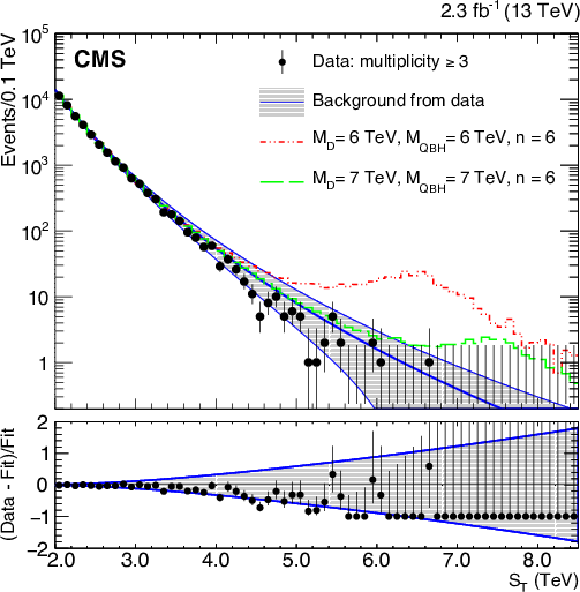
png pdf |
Figure 2-b:
The distribution of the total transverse energy, $ {S_{\mathrm {T}}} $, for inclusive multiplicities of objects (electrons, muons, photons, or jets) $N\geq $ 3. Observed data are shown by points with error bars, the solid blue lines along with the grey shaded band show the main background estimation (central blue line), along with the uncertainty band (outer blue lines). The deviation of the fit from the data is shown in the lower pane. The top also shows predictions for two quantum black hole benchmark scenarios added to the corresponding background predictions. |
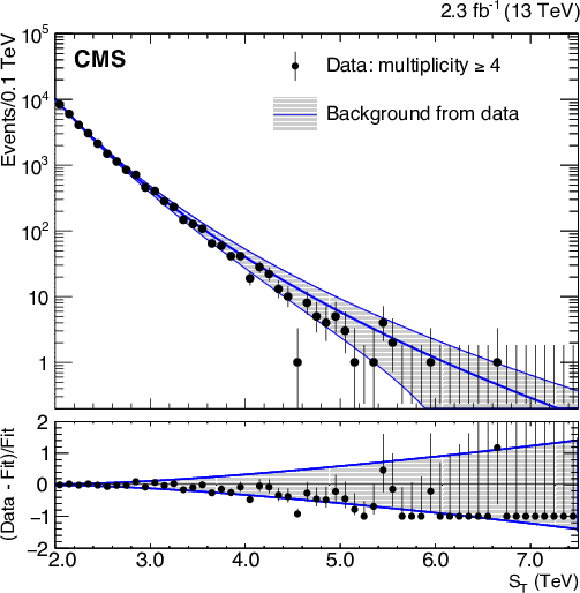
png pdf |
Figure 2-c:
The distribution of the total transverse energy, $ {S_{\mathrm {T}}} $, for inclusive multiplicities of objects (electrons, muons, photons, or jets) $N\geq $ 4. Observed data are shown by points with error bars, the solid blue lines along with the grey shaded band show the main background estimation (central blue line), along with the uncertainty band (outer blue lines). The deviation of the fit from the data is shown in the lower pane. |
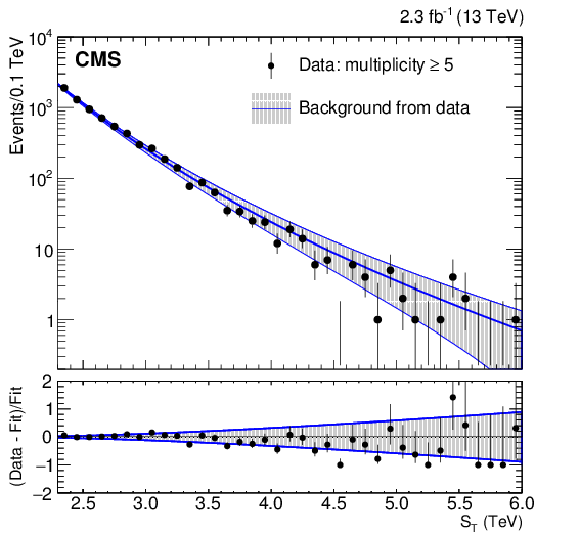
png pdf |
Figure 2-d:
The distribution of the total transverse energy, $ {S_{\mathrm {T}}} $, for inclusive multiplicities of objects (electrons, muons, photons, or jets) $N\geq $ 5. Observed data are shown by points with error bars, the solid blue lines along with the grey shaded band show the main background estimation (central blue line), along with the uncertainty band (outer blue lines). The deviation of the fit from the data is shown in the lower pane. |

png pdf |
Figure 3:
The distributions of the total transverse energy, $ {S_{\mathrm {T}}} $, for inclusive multiplicities of objects (photons, muons, photons, or jets) $N\geq $ 6, 7, 8, 9, 10. Observed data are shown by points with error bars, the solid blue lines along with the grey shaded band show the main background estimation (central blue line), along with the uncertainty band (outer blue lines). The deviation of the fit from the data is shown in each lower pane. The lower three plots also show predictions for two semiclassical black hole signal benchmarks added to the corresponding background predictions. |
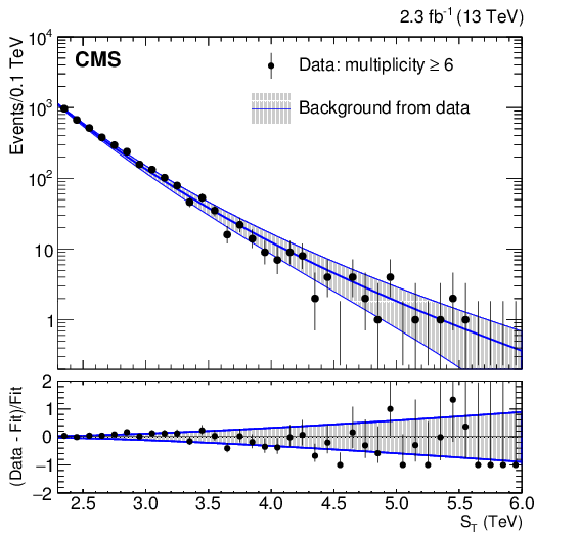
png pdf |
Figure 3-a:
The distribution of the total transverse energy, $ {S_{\mathrm {T}}} $, for inclusive multiplicities of objects (photons, muons, photons, or jets) $N\geq $ 6. Observed data are shown by points with error bars, the solid blue lines along with the grey shaded band show the main background estimation (central blue line), along with the uncertainty band (outer blue lines). The deviation of the fit from the data is shown in the lower pane. |

png pdf |
Figure 3-b:
The distribution of the total transverse energy, $ {S_{\mathrm {T}}} $, for inclusive multiplicities of objects (photons, muons, photons, or jets) $N\geq $ 7. Observed data are shown by points with error bars, the solid blue lines along with the grey shaded band show the main background estimation (central blue line), along with the uncertainty band (outer blue lines). The deviation of the fit from the data is shown in the lower pane. |
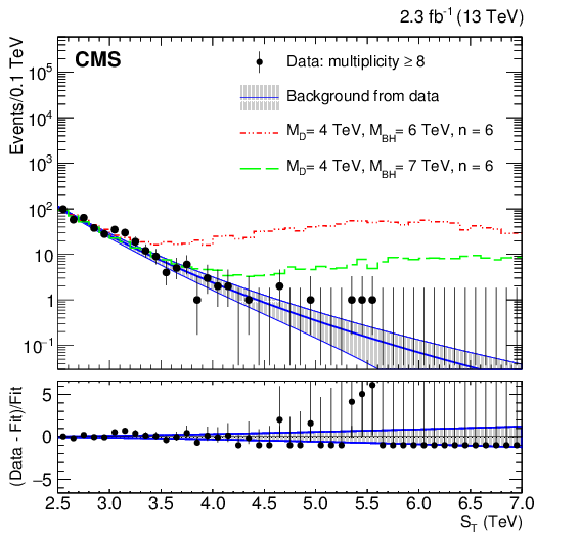
png pdf |
Figure 3-c:
The distribution of the total transverse energy, $ {S_{\mathrm {T}}} $, for inclusive multiplicities of objects (photons, muons, photons, or jets) $N\geq $ 8. Observed data are shown by points with error bars, the solid blue lines along with the grey shaded band show the main background estimation (central blue line), along with the uncertainty band (outer blue lines). The deviation of the fit from the data is shown in the lower pane. The plot also shows predictions for two semiclassical black hole signal benchmarks added to the corresponding background predictions. |
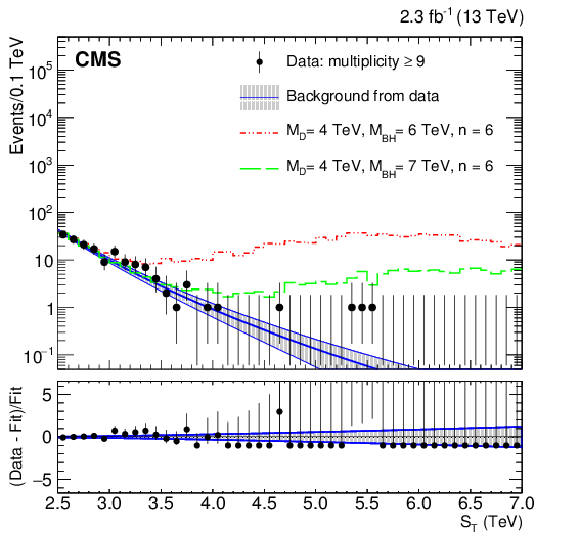
png pdf |
Figure 3-d:
The distribution of the total transverse energy, $ {S_{\mathrm {T}}} $, for inclusive multiplicities of objects (photons, muons, photons, or jets) $N\geq $ 9. Observed data are shown by points with error bars, the solid blue lines along with the grey shaded band show the main background estimation (central blue line), along with the uncertainty band (outer blue lines). The deviation of the fit from the data is shown in the lower pane. The plot also shows predictions for two semiclassical black hole signal benchmarks added to the corresponding background predictions. |
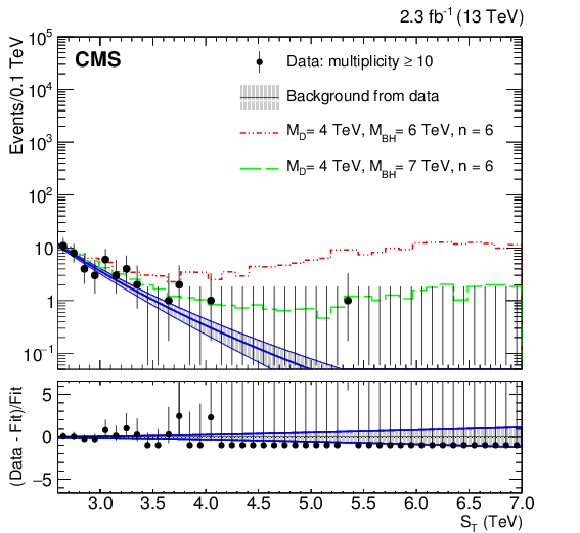
png pdf |
Figure 3-e:
The distribution of the total transverse energy, $ {S_{\mathrm {T}}} $, for inclusive multiplicities of objects (photons, muons, photons, or jets) $N\geq $ 10. Observed data are shown by points with error bars, the solid blue lines along with the grey shaded band show the main background estimation (central blue line), along with the uncertainty band (outer blue lines). The deviation of the fit from the data is shown in the lower pane. The plot also shows predictions for two semiclassical black hole signal benchmarks added to the corresponding background predictions. |
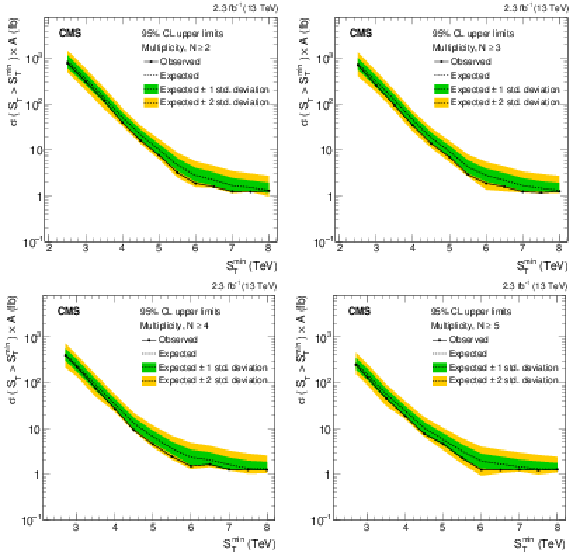
png pdf |
Figure 4:
Model-independent 95% CL upper limits on the cross section times acceptance for four sets of inclusive multiplicity thresholds: $N \ge $ 2, 3, 4, and 5. Observed (expected) limits are shown as solid (dashed) lines, and the two bands correspond to $\pm $1 and 2 standard deviations in the expected limit. |

png pdf |
Figure 4-a:
Model-independent 95% CL upper limits on the cross section times acceptance for inclusive multiplicity threshold $N \ge $ 2. Observed (expected) limits are shown as solid (dashed) lines, and the two bands correspond to $\pm $1 and 2 standard deviations in the expected limit. |

png pdf |
Figure 4-b:
Model-independent 95% CL upper limits on the cross section times acceptance for inclusive multiplicity threshold $N \ge $ 3. Observed (expected) limits are shown as solid (dashed) lines, and the two bands correspond to $\pm $1 and 2 standard deviations in the expected limit. |
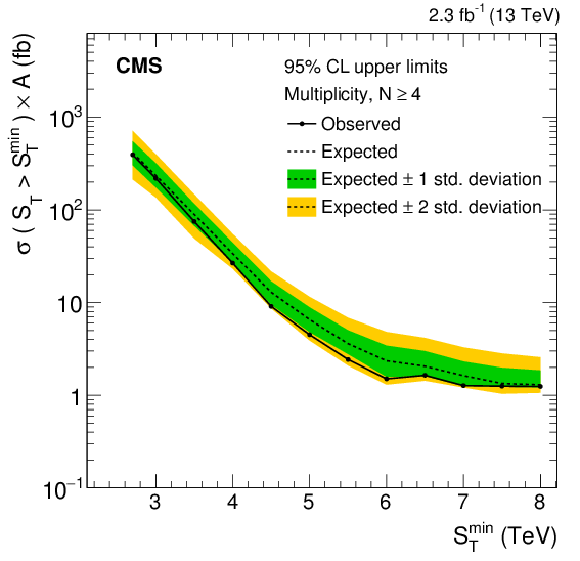
png pdf |
Figure 4-c:
Model-independent 95% CL upper limits on the cross section times acceptance for inclusive multiplicity threshold $N \ge $ 4. Observed (expected) limits are shown as solid (dashed) lines, and the two bands correspond to $\pm $1 and 2 standard deviations in the expected limit. |
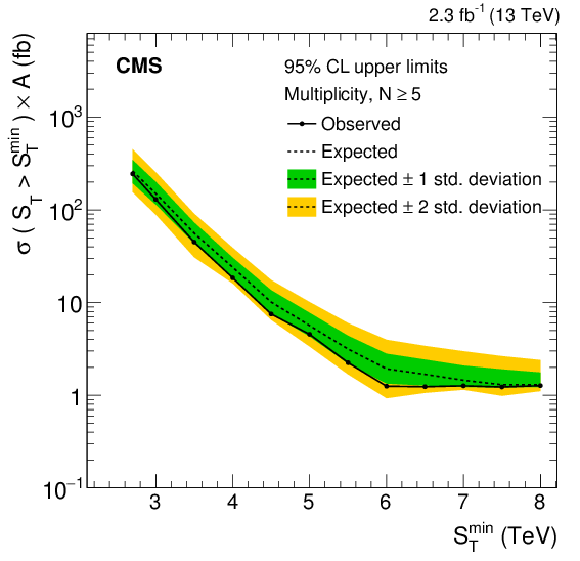
png pdf |
Figure 4-d:
Model-independent 95% CL upper limits on the cross section times acceptance for inclusive multiplicity threshold $N \ge $ 5. Observed (expected) limits are shown as solid (dashed) lines, and the two bands correspond to $\pm $1 and 2 standard deviations in the expected limit. |

png pdf |
Figure 5:
Model-independent 95% CL upper limits on the cross section times acceptance for five sets of inclusive multiplicity thresholds: $N \ge $ 6, 7, 8, 9, and 10. Observed (expected) limits are shown as a solid (dashed) lines, and the two bands correspond to $\pm $1 and 2 standard deviations in the expected limit. |
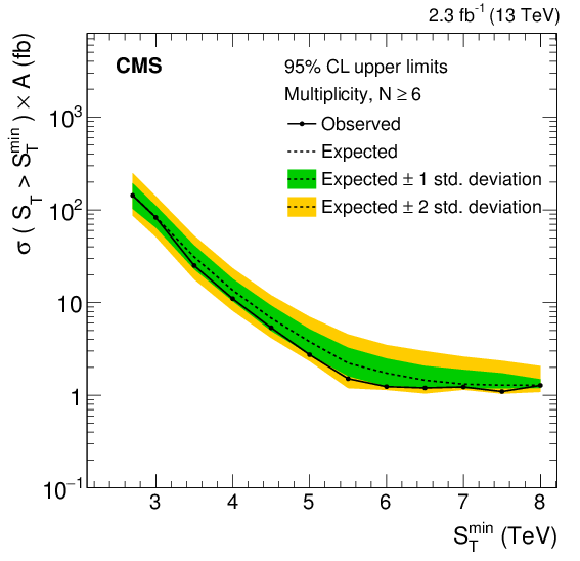
png pdf |
Figure 5-a:
Model-independent 95% CL upper limits on the cross section times acceptance for inclusive multiplicity threshold $N \ge $ 6. Observed (expected) limits are shown as a solid (dashed) lines, and the two bands correspond to $\pm $1 and 2 standard deviations in the expected limit. |

png pdf |
Figure 5-b:
Model-independent 95% CL upper limits on the cross section times acceptance for inclusive multiplicity threshold $N \ge $ 7. Observed (expected) limits are shown as a solid (dashed) lines, and the two bands correspond to $\pm $1 and 2 standard deviations in the expected limit. |
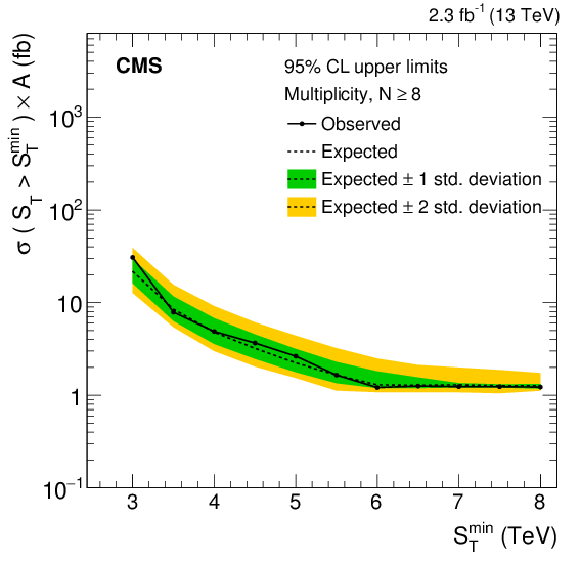
png pdf |
Figure 5-c:
Model-independent 95% CL upper limits on the cross section times acceptance for inclusive multiplicity threshold $N \ge $ 8. Observed (expected) limits are shown as a solid (dashed) lines, and the two bands correspond to $\pm $1 and 2 standard deviations in the expected limit. |
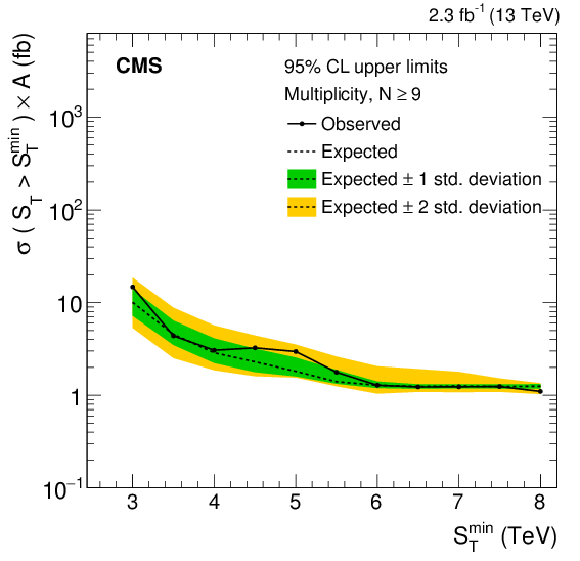
png pdf |
Figure 5-d:
Model-independent 95% CL upper limits on the cross section times acceptance for inclusive multiplicity threshold $N \ge $ 9. Observed (expected) limits are shown as a solid (dashed) lines, and the two bands correspond to $\pm $1 and 2 standard deviations in the expected limit. |

png pdf |
Figure 5-e:
Model-independent 95% CL upper limits on the cross section times acceptance for inclusive multiplicity threshold $N \ge $ 10. Observed (expected) limits are shown as a solid (dashed) lines, and the two bands correspond to $\pm $1 and 2 standard deviations in the expected limit. |

png pdf |
Figure 6:
The 95% CL lower limits on the minimum semiclassical black hole mass as a function of the Planck scale $ {M_\mathrm {D}} $, for several benchmark models generated with BlackMax: nonrotating and rotating black holes without graviton emission and rotating black holes with energy-momentum loss. |
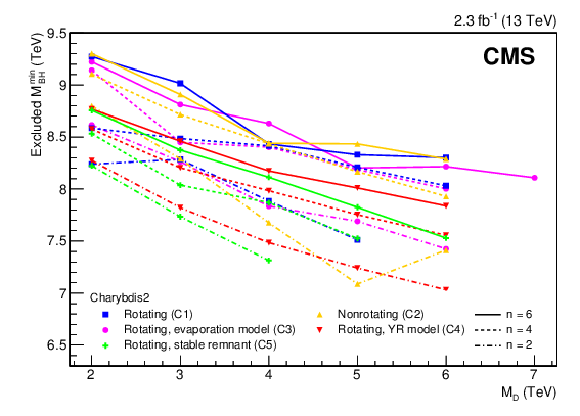
png pdf |
Figure 7:
The 95% CL lower limits on minimum semiclassical black hole mass as a function of the Planck scale $ {M_\mathrm {D}} $, for several benchmark models generated with charybdis-2: rotating and nonrotating black holes, rotating black holes with an alternative evaporation model, rotating black holes with Yoshino-Rychkov suppression, and rotating black holes with a stable remnant. |
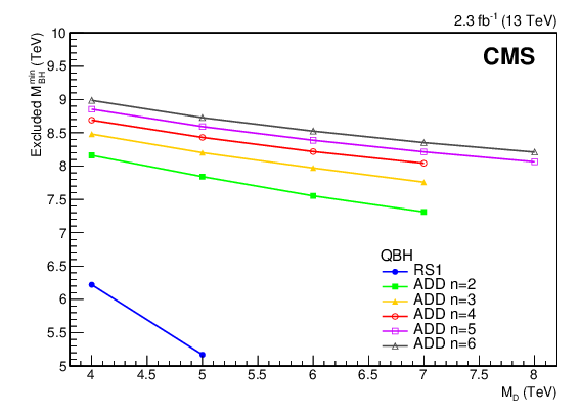
png pdf |
Figure 8:
The 95% CL lower limits on minimum quantum black hole mass as a function of the Planck scale $ {M_\mathrm {D}} $, for several benchmark models. The blue (lower) line corresponds to quantum black holes in the RS1 model; while the other lines correspond to the ADD model for the number of extra dimensions $n = $ 2,..., 6. |

png pdf |
Figure 9:
The 95% CL upper limits on the cross section for the production of string balls and the corresponding theoretical cross sections. The solid colored lines correspond to the observed cross section limits; the dashed colored curves correspond to theoretical cross sections. |
| Tables | |

png pdf |
Table 1:
Generator settings for various semiclassical BH model points probed in this analysis. These parameters are defined in Refs. [56] and [57] for the BlackMax and charybdis-2 generators, respectively. The generator settings not specified are kept at their default values. |

png pdf |
Table 2:
The normalization regions and the corresponding $N = $ 2 background template normalization factors $s$ and their uncertainties for inclusive multiplicities, $ N\geq $ 2...10. The normalization factor uncertainties are given by $ s/\sqrt {N_\mathrm {NR}}$, where $N_\mathrm {NR}$ is the number of events in each normalization region. |

png pdf |
Table 3:
Summary of the systematic uncertainties. The range of the background uncertainties correspond to the $ {S_{\mathrm {T}}} $ range probed. A dash implies that the corresponding uncertainty source does not apply. |
| Summary |
| We have conducted a search for new physics in multiparticle final states in a data sample of proton-proton collisions at $\sqrt{s} = $ 13 TeV collected with the CMS detector, corresponding to an integrated luminosity of 2.3 fb$^{-1}$. The discriminating variable between signal and the dominant QCD multijet background is the scalar sum of the transverse energies of all reconstructed objects in the event, ${S_{\mathrm{T}}} $. The shape of the ${S_{\mathrm{T}}} $ distribution in low-multiplicity data is used to predict the QCD multijet background in high-multiplicity signal regions. No significant excess of events over the standard model expectation is observed in any of the analyzed final-state multiplicities. Comparing the ${S_{\mathrm{T}}} $ distribution in data with that from the background prediction, we set model-independent upper limits at 95% confidence level on the product of the cross section and the acceptance for hypothetical signals. In addition, we set limits on various theoretical black hole and string ball models, including models of rotating and nonrotating black holes and quantum black holes. In all cases the exclusions represent significant improvements over the limits achieved in Run 1 of the LHC. |
| References | ||||
| 1 | S. L. Glashow | partial symmetries of weak interactions | Nucl. Phys. 22 (1961) 579 | |
| 2 | S. Weinberg | A Model of Leptons | PRL 19 (1967) 1264 | |
| 3 | A. Salam | Weak and electromagnetic interactions | in Elementary particle physics: relativistic groups and analyticity, N. Svartholm, ed., p. 367 Almqvist \& Wiksell, Stockholm, 1968 Proceedings of the eighth Nobel symposium | |
| 4 | R. Barbieri and G. F. Giudice | Upper bounds on supersymmetric particle masses | Nucl. Phys. B 306 (1988) 63 | |
| 5 | G. R. Farrar and P. Fayet | Phenomenology of the production, decay, and Detection of New Hadronic States Associated with Supersymmetry | PLB 76 (1978) 575 | |
| 6 | S. P. Martin | A Supersymmetry Primer | in Perspectives on Supersymmetry II, G. L. Kane, ed., p. 1 World Scientific | hep-ph/9709356 |
| 7 | J. A. Evans, Y. Kats, D. Shih, and M. J. Strassler | Toward full LHC coverage of natural supersymmetry | JHEP 07 (2014) 101 | 1310.5758 |
| 8 | S. Dimopoulos and L. Susskind | Mass without scalars | Nucl. Phys. B 155 (1979) 237, .[2,930(1979)] | |
| 9 | P. H. Frampton and S. L. Glashow | Chiral color: An alternative to the standard model | PLB 190 (1987) 157 | |
| 10 | C. T. Hill | Topcolor: Top quark condensation in a gauge extension of the standard model | PLB 266 (1991) 419 | |
| 11 | C. T. Hill and S. J. Parke | Top production: Sensitivity to new physics | PRD 49 (1994) 4454 | hep-ph/9312324 |
| 12 | R. S. Chivukula, A. G. Cohen, and E. H. Simmons | New strong interactions at the Tevatron? | PLB 380 (1996) 92 | hep-ph/9603311 |
| 13 | E. H. Simmons | Coloron phenomenology | PRD 55 (1997) 1678 | hep-ph/9608269 |
| 14 | N. Arkani-Hamed, S. Dimopoulos, and G. R. Dvali | The hierarchy problem and new dimensions at a millimeter | PLB 429 (1998) 263 | hep-ph/9803315 |
| 15 | I. Antoniadis, N. Arkani-Hamed, S. Dimopoulos, and G. R. Dvali | New dimensions at a millimeter to a fermi and superstrings at a TeV | PLB 436 (1998) 257 | hep-ph/9804398 |
| 16 | N. Arkani-Hamed, S. Dimopoulos, and G. R. Dvali | Phenomenology, astrophysics and cosmology of theories with submillimeter dimensions and TeV scale quantum gravity | PRD 59 (1999) 086004 | hep-ph/9807344 |
| 17 | L. Randall and R. Sundrum | A large mass hierarchy from a small extra dimension | PRL 83 (1999) 3370 | hep-ph/9905221 |
| 18 | L. Randall and R. Sundrum | An Alternative to Compactification | PRL 83 (1999) 4690 | hep-th/9906064 |
| 19 | S. Dimopoulos and G. L. Landsberg | Black holes at the LHC | PRL 87 (2001) 161602 | hep-ph/0106295 |
| 20 | S. B. Giddings and S. D. Thomas | High energy colliders as black hole factories: The end of short distance physics | PRD 65 (2002) 056010 | hep-ph/0106219 |
| 21 | L. A. Anchordoqui, H. Goldberg, and A. D. Shapere | Phenomenology of Randall-Sundrum black holes | PRD 66 (2002) 024033 | hep-ph/0204228 |
| 22 | G. L. Landsberg | Black holes at future colliders and beyond | JPG 32 (2006) R337 | hep-ph/0607297 |
| 23 | P. Meade and L. Randall | Black holes and quantum gravity at the LHC | JHEP 05 (2008) 003 | 0708.3017 |
| 24 | R. C. Myers and M. J. Perry | Black holes in higher dimensional space-times | Annals Phys. 172 (1986) 304 | |
| 25 | S. W. Hawking | Particle creation by black holes | Commun. Math. Phys. 43 (1975) 199 | |
| 26 | X. Calmet, W. Gong, and S. D. H. Hsu | Colorful quantum black holes at the LHC | PLB 668 (2008) 20 | 0806.4605 |
| 27 | D. M. Gingrich | Quantum black holes with charge, color and spin at the LHC | JPG 37 (2010) 105008 | 0912.0826 |
| 28 | D. M. Gingrich | Monte Carlo event generator for black hole production and decay in proton--proton collisions -- QBH version 1.02 | CPC 181 (2010) 1917 | 0911.5370 |
| 29 | S. Dimopoulos and R. Emparan | String balls at the LHC and beyond | PLB 526 (2002) 393 | hep-ph/0108060 |
| 30 | R. Hagedorn | Statistical thermodynamics of strong interactions at high-energies | Nuovo Cim. Suppl. 3 (1965)147 | |
| 31 | G. Landsberg | Black Holes at the Large Hadron Collider | Fundam. Theor. Phys. 178 (2015) 267 | |
| 32 | ATLAS Collaboration | Search for new phenomena in dijet mass and angular distributions from $ pp $ collisions at $ \sqrt{s}= $ 13 TeV with the ATLAS detector | PLB 754 (2016) 302 | 1512.01530 |
| 33 | ATLAS Collaboration | Search for strong gravity in multijet final states produced in pp collisions at $ \sqrt{s} = $ 13 TeV using the ATLAS detector at the LHC | JHEP 03 (2016) 026 | 1512.02586 |
| 34 | CMS Collaboration | Search for microscopic black hole signatures at the Large Hadron Collider | PLB 697 (2011) 434 | CMS-EXO-10-017 1012.3375 |
| 35 | CMS Collaboration | Search for microscopic black holes in pp collisions at $ \sqrt{s} = $ 7 TeV | JHEP 04 (2012) 061 | CMS-EXO-11-071 1202.6396 |
| 36 | CMS Collaboration | Search for microscopic black holes in pp collisions at $ \sqrt{s} = $ 8 TeV | JHEP 07 (2013) 178 | CMS-EXO-12-009 1303.5338 |
| 37 | CMS Collaboration | Search for stealth supersymmetry in events with jets, either photons or leptons, and low missing transverse momentum in pp collisions at 8 TeV | PLB 743 (2015) 503 | CMS-SUS-14-009 1411.7255 |
| 38 | CMS Collaboration | Search for new physics in events with high jet multiplicity and low missing transverse momentum in proton-proton collisions at $ \sqrt{s} = $ 8 TeV | PLB (2017) | CMS-EXO-13-001 1608.01224 |
| 39 | ATLAS Collaboration | Search for TeV-scale gravity signatures in final states with leptons and jets with the ATLAS detector at $ \sqrt{s} = $ 7 TeV | PLB 716 (2013) 122 | 1204.4646 |
| 40 | ATLAS Collaboration | Search for microscopic black holes and string balls in final states with leptons and jets with the ATLAS detector at $ \sqrt{s} = $ 8 TeV | JHEP 08 (2014) 103 | 1405.4254 |
| 41 | ATLAS Collaboration | Search for low-scale gravity signatures in multi-jet final states with the ATLAS detector at $ \sqrt{s} = $ 8 TeV | JHEP 07 (2015) 032 | 1503.08988 |
| 42 | CMS Collaboration | Description and performance of track and primary-vertex reconstruction with the CMS tracker | JINST 9 (2014) P10009 | CMS-TRK-11-001 1405.6569 |
| 43 | CMS Collaboration | The CMS trigger system | JINST 12 (2017) P01020 | |
| 44 | CMS Collaboration | The CMS Experiment at the CERN LHC | JINST 3 (2008) S08004 | CMS-00-001 |
| 45 | CMS Collaboration | Particle--Flow Event Reconstruction in CMS and Performance for Jets, Taus, and $ E_{\mathrm{T}}^{\text{miss}} $ | ||
| 46 | CMS Collaboration | Commissioning of the Particle-Flow Event Reconstruction with the first LHC collisions recorded in the CMS detector | ||
| 47 | CMS Collaboration | Performance of the CMS missing transverse momentum reconstruction in pp data at $ \sqrt{s} = $ 8 TeV | JINST 10 (2015) P02006 | CMS-JME-13-003 1411.0511 |
| 48 | M. Cacciari, G. P. Salam, and G. Soyez | The anti-$ k_t $ jet clustering algorithm | JHEP 04 (2008) 063 | 0802.1189 |
| 49 | M. Cacciari, G. P. Salam, and G. Soyez | FastJet user manual | EPJC 72 (2012) 1896 | 1111.6097 |
| 50 | CMS Collaboration | Determination of jet energy calibration and transverse momentum resolution in CMS | JINST (2011) P11002 | CMS-JME-10-011 1107.4277 |
| 51 | CMS Collaboration | Jet energy scale and resolution in the CMS experiment in pp collisions at 8 TeV | JINST (2017) P02014 | CMS-JME-13-004 1607.03663 |
| 52 | M. Cacciari and G. P. Salam | Pileup subtraction using jet areas | PLB 659 (2008) 119 | 0707.1378 |
| 53 | CMS Collaboration | Performance of CMS muon reconstruction in pp collision events at $ \sqrt{s} = $ 7 TeV | JINST (2012) P10002 | CMS-MUO-10-004 1206.4071 |
| 54 | CMS Collaboration | Performance of Electron Reconstruction and Selection with the CMS Detector in Proton-Proton Collisions at $ \sqrt{s} = $ 8 TeV | JINST 10 (2015) P06005 | CMS-EGM-13-001 1502.02701 |
| 55 | CMS Collaboration | Performance of Photon Reconstruction and Identification with the CMS Detector in Proton-Proton Collisions at $ \sqrt{s} = $ 8 TeV | JINST 10 (2015) P08010 | CMS-EGM-14-001 1502.02702 |
| 56 | D.-C. Dai et al. | BlackMax: A black-hole event generator with rotation, recoil, split branes, and brane tension | PRD 77 (2008) 076007 | 0711.3012 |
| 57 | C. M. Harris, P. Richardson, and B. R. Webber | CHARYBDIS: a black hole event generator | JHEP 08 (2003) 033 | hep-ph/0307305 |
| 58 | T. Sj$ {M_\mathrm {D}} $ostrand et al. | An introduction to PYTHIA 8.2 | CPC 191 (2015) 159 | 1410.3012 |
| 59 | CMS Collaboration | Event generator tunes obtained from underlying event and multiparton scattering measurements | EPJC 76 (2016) 155 | CMS-GEN-14-001 1512.00815 |
| 60 | H. Yoshino and V. S. Rychkov | Improved analysis of black hole formation in high-energy particle collisions | PRD 71 (2005) 104028 | hep-th/0503171 |
| 61 | A. D. Martin, W. J. Stirling, R. S. Thorne, and G. Watt | Parton distributions for the LHC | EPJC 63 (2009) 189 | 0901.0002 |
| 62 | A. D. Martin, W. J. Stirling, R. S. Thorne, and G. Watt | Heavy-quark mass dependence in global PDF analyses and 3- and 4-flavour parton distributions | EPJC 70 (2010) 51 | 1007.2624 |
| 63 | NNPDF Collaboration | Parton distributions for the LHC Run II | JHEP 04 (2015) 040 | 1410.8849 |
| 64 | L. A. Harland-Lang, A. D. Martin, P. Motylinski, and R. S. Thorne | Parton distributions in the LHC era: MMHT 2014 PDFs | EPJC 75 (2015) 204 | 1412.3989 |
| 65 | Geant4 Collaboration | Geant4 toolkit for simulation of HEP experiments | NIMA 502 (2003) 666 | |
| 66 | Orbaker, Douglas (on behalf of the CMS Collaboration) | Fast simulation of the CMS detector | J. Phys. Conf. Ser. 219 (2010) 032053 | |
| 67 | J. Alwall et al. | The automated computation of tree-level and next-to-leading order differential cross sections, and their matching to parton shower simulations | JHEP 07 (2014) 079 | 1405.0301 |
| 68 | CDF Collaboration | Search for new particles decaying into dijets in proton-antiproton collisions at $ \sqrt{s} = $ 1.96 TeV | PRD 79 (2009) 112002 | 0812.4036 |
| 69 | CMS Collaboration | Search for narrow resonances decaying to dijets in proton-proton collisions at $ \sqrt{s} = $ 13 TeV | PRL 116 (2016) 071801 | CMS-EXO-15-001 1512.01224 |
| 70 | J. Pumplin et al. | New generation of parton distributions with uncertainties from global QCD analysis | JHEP 07 (2002) 012 | hep-ph/0201195 |
| 71 | H.-L. Lai et al. | New parton distributions for collider physics | PRD 82 (2010) 074024 | 1007.2241 |
| 72 | S. Alekhin et al. | The PDF4LHC Working Group Interim Report | 1101.0536 | |
| 73 | M. Botje et al. | The PDF4LHC Working Group Interim Recommendations | 1101.0538 | |
| 74 | CMS Collaboration | CMS Luminosity Measurement for the 2015 Data Taking Period | ||
| 75 | T. Junk | Confidence level computation for combining searches with small statistics | NIMA 434 (1999) 435 | hep-ex/9902006 |
| 76 | A. L. Read | Presentation of search results: the $ CL_s $ technique | JPG 28 (2002) 26934 | |
| 77 | ATLAS and CMS Collaborations | Procedure for the LHC Higgs boson search combination in Summer 2011 | ATLAS-PHYS-PUB-2011-011, CMS Note 2011/005 | |
| 78 | R. D. Cousins, J. T. Linnemann, and J. Tucker | Evaluation of three methods for calculating statistical significance when incorporating a systematic uncertainty into a test of the background-only hypothesis for a Poisson process | NIMA 595 (2008) 480 | |

|
Compact Muon Solenoid LHC, CERN |

|

|

|

|

|

|